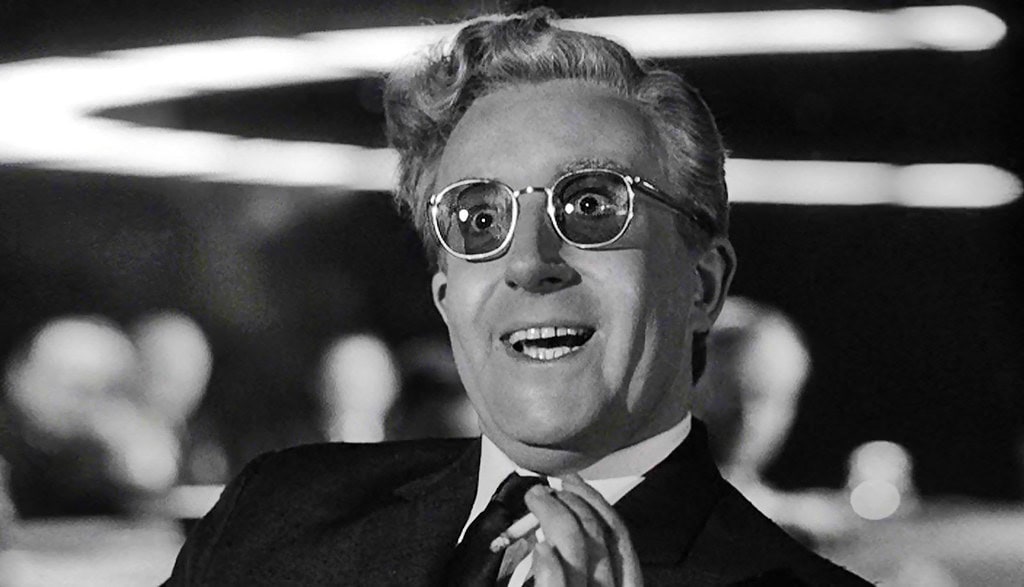Dr. Strangelove: A Study in Cold War Anxieties
The Historical Value of Black and White Films
I wrote an article about learning history through black-and-white film a while back. Black-and-white films can be excellent ways to expose kids to history because, given enough time, any piece of cinema will become “historical” just by virtue of reflecting technologies, attitudes, and patterns of life that have long since vanished. In a sense, these films become the visual equivalent of primary source texts.
Dr. Strangelove: A Satirical Critique of the Cold War
For those of you studying modern history and the Cold War, an indispensable film to review is Stanley Kubrick’s 1964 dark satire, Dr. Strangelove or How I Learned to Stop Worrying and Love the Bomb. Released shortly after the Cuban Missile Crisis at the height of the Cold War, Dr. Strangelove offers a satirical critique of the attitudes and policies of the Cold War era. It stars Peter Sellers (in three roles), George C. Scott, and a host of other notables from Hollywood’s late golden age. (Those who pay attention will notice a young James Earl Jones playing a minor character in his film debut.) The film won numerous awards and to this day is considered one of the greatest political satires, indeed, one of the greatest films of all time. The Writer’s Guild of America ranked it 12th best screenplay ever written.
The plot is about a rogue U.S. military officer who has lost his mind and ordered a nuclear strike against the Soviet Union and the attempts of the United States and Britain to halt the strike before the whole world is engulfed in nuclear war. Though the plot is entirely fictional, Dr. Strangelove is a fantastic exploration of people’s anxieties during the Cold War, expressed through satire and comedy. As the Cold War ended in 1991, children today are unlikely to understand the societal fears of the Cold War era, where people lived in constant alarm about potential nuclear annihilation. The film is thus a great introduction to the zeitgeist of the age.
The Doctrine of Mutually Assured Destruction (MAD)
Beyond that, however, the film offers a mockery of the Cold War era doctrine of mutually assured destruction (MAD), the idea that the U.S.A. and Russia are supposed to be deterred from a nuclear exchange by the prospect of a civilization-ending apocalypse, no matter who “won.” Paradoxically, MAD created a scenario where the surest path to peace was believed to be the proliferation of more numerous and powerful nuclear weapons, based on the assumption that each side would be less likely to use them due to the catastrophic consequences of such an exchange.
While, in retrospect, the doctrine of MAD appears to have prevented the Cold War from escalating into a hot war, its success was far from certain at the time. Dr. Strangelove presents what I would call the skeptical attitude towards the American approach, reflecting the fear that our strategy for avoiding war will recklessly precipitate the very nuclear holocaust it was intended to prevent, which was a major concern of the era.
The Dangers of Automated Systems
Of striking relevance today is the movie’s theme of the dangers of “smart” technology that is created to make decisions independent of human agency. In the film, the Soviet Union possesses a retaliatory system called the Doomsday Machine, which was developed as the ultimate nuclear deterrent. The Doomsday Machine is designed to initiate an automatic nuclear retaliation against the United States completely independent of any human directive and cannot be countermanded. The resulting nuclear fallout from the Doomsday Machine will make the surface of the earth uninhabitable for 93 years. It does not matter that the impending American attack has been called by mistake; the Doomsday Device will automatically retaliate with a nuclear salvo that promises to obliterate the vast majority of the human race. Much of the film’s plot centers on the protagonists’ attempts to halt this inevitable chain of destruction.
Though Dr. Strangelove was decades ahead of anything like generative AI, it is fascinating to see that way back in 1964, people were already concerned about the dangers of entrusting vital aspects of our national security to automated systems incapable of human discernment.
The Humor and Performances
The film is a dark comedy, and as such its humor is not in gags played for laughs but in the inherent ridiculousness of many of the scenarios and discussions, which are played entirely straight—the point being to use reductio ad absurdam humor to highlight the dangers in Cold War policy. Peter Sellers, George C. Scott and the others offer wonderful performances, as do the other cast members.
Conclusion: Understanding the Cold War Through Film
If you want to understand the zeitgeist of the Cold War, I highly recommend watching this film in conjunction with your lessons on the 1950s and 60s. It’s a great insight into the Cold War’s deeply felt concerns and one of modern cinema’s masterpieces.
What are your thoughts on this topic? Join me and other homeschooling parents at our Homeschool Connections Community or our Facebook group to continue the discussion!






